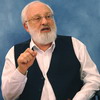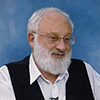I had a conversation that was recorded called “Kabbalists Write.” We discussed my fourth book, Attaining the Worlds Beyond. I spoke with Ben-Tzion Gertz, a writer and an editor of several of my books in Hebrew.
Immediately after my teacher’s passing (September 1991), I had to go to Toronto to visit my dying father. I wrote this book after I returned, following the death of my father (February 1992). I think that more than any other of my books, it conveys the feelings of a person who is beginning the path of Kabbalah, one’s impressions from encountering the world of Kabbalah. This is exactly how I saw this book – the first of a series of books that I would write.
Here is an introductory chapter from the book Attaining the Worlds Beyond:
“The need for this text became apparent to me from the questions that I received from my students, and from the questions that were asked during various lectures and radio programs, as well as from the letters that continue to flood in from all over the world.
The difficulty of explaining and teaching Kabbalah lies in the fact that the spiritual world has no counterpart in our world. Even if the object of our studies becomes clear, our understanding of it is only temporary. What we learn is grasped by the spiritual component of our ability to understand, which is constantly renewed from Above. Thus, a subject we initially understand may appear unclear at a later date. Depending on our mood and our spiritual state, the text can appear as either full of deep meaning, or entirely meaningless.
Do not despair if what was so clear yesterday becomes very confusing today. Do not give up if the text appears to be vague, strange, or illogical. Kabbalah is not studied for the sake of acquiring theoretical knowledge, but to help us see and perceive what is hidden from us. When, after we have contemplated and acquired spiritual strength, we begin to see and perceive, then our ability to attain the resulting spiritual lights and levels will bring us to true knowledge.
Until we can comprehend the Upper Light and can perceive what it presents to us, we will not understand how the universe is built and how it works, since there are no analogies to these concepts in our own world.
This text can help ease our first steps toward perceiving the spiritual forces. At later stages, we will be able to progress only with the help of a teacher.
This text should not be read in an ordinary fashion. Rather, we should concentrate on a paragraph, think about it, and attempt to understand examples that reflect in the issues discussed. We may then try to apply these issues to our own personal experiences.
We should patiently and repeatedly read and think about each sentence as we try to penetrate the author’s feelings. We should also read slowly, trying to extract the nuances of what is written, and if need be, return to the beginning of each sentence.
This method can either help us delve into the material with our own feelings, or recognize that our feelings are lacking regarding a particular issue. If the latter is the case, it is a crucial prerequisite for us to move forward spiritually.
This text is not written for quick reading. Though it deals with one subject only, ‘How to relate to the Creator,’ it deals with it in different ways. This allows each of us to find the particular phrase or word that will transport us into the depths of the text.
Although the desires and actions of egoism are described in the third person, until we can separate our personal consciousness from our desires, we should consider the aspirations and desires of egoism our own. The word “body” in the text does not relate to the physical self, but to ‘egoism,’ our desire to receive.
To get the most out of this material, I recommend reading the same passages at different times and in different states of mind. By doing so, you can better acquaint yourself with your reactions and attitudes towards the same text on different occasions.
Disagreeing with the material is always positive, as is agreeing with it. The most important aspect of reading the text is your response to it. A feeling of disagreement indicates you have reached the preliminary stage (achoraim, the backside) of understanding, which prepares you for the next stage of perception (panim, face).
It is precisely through this slow meaningful manner of reading that you can develop feelings, or ‘vessels’ (kelim). These are necessary for us to receive spiritual sensations. Once the vessels are in place, the Upper Light will be able to enter them. Prior to their formation, the Light merely exists around you, surrounding your soul, although you cannot perceive it.
This text is not written to enhance your knowledge. Nor is it meant to be memorized. In fact, we must never test ourselves on the material.
It is even better if we forget the contents altogether, so that the second reading will seem fresh and entirely unfamiliar. By forgetting the material, it implies that we have grasped the previous sensations and that they have now subsided, leaving a space to be filled by sensations we have yet to experience. The process of developing new sensory organs is constantly renewed and accumulated in the spiritual, unperceived sphere of our souls.
The most important aspect of our reading is the way we feel about the material while reading it, not afterwards. Once we experience these feelings, they become revealed within the heart and mind, and manifest themselves when they are needed in the continuous process of the soul’s development.
Rather than rushing to complete reading the text, it is recommended to concentrate on the sections that appeal to us the most. Only then will the text be able to help and guide us in our search for personal spiritual ascent. The goal of this text is to help us become interested in the mysteries of life, such as:
Why were we born into this world? Can we enter the spiritual worlds from here? Can we ever understand the purpose of the creation? Is it possible to perceive the Creator, eternity and immortality? How can we begin to grow spiritually?”
Related Material:
Purchase the book – Attaining the Worlds Beyond
Kabbalah In Our Times – Spirituality, Kabbalah and the 21st Century
Filed under: Spirituality - No Comments →
 Questions I received on the soul and its relationship with the body:
Questions I received on the soul and its relationship with the body:
 Questions I received on studying, defining the spiritual goal, one’s desires, and one’s mind:
Questions I received on studying, defining the spiritual goal, one’s desires, and one’s mind:






